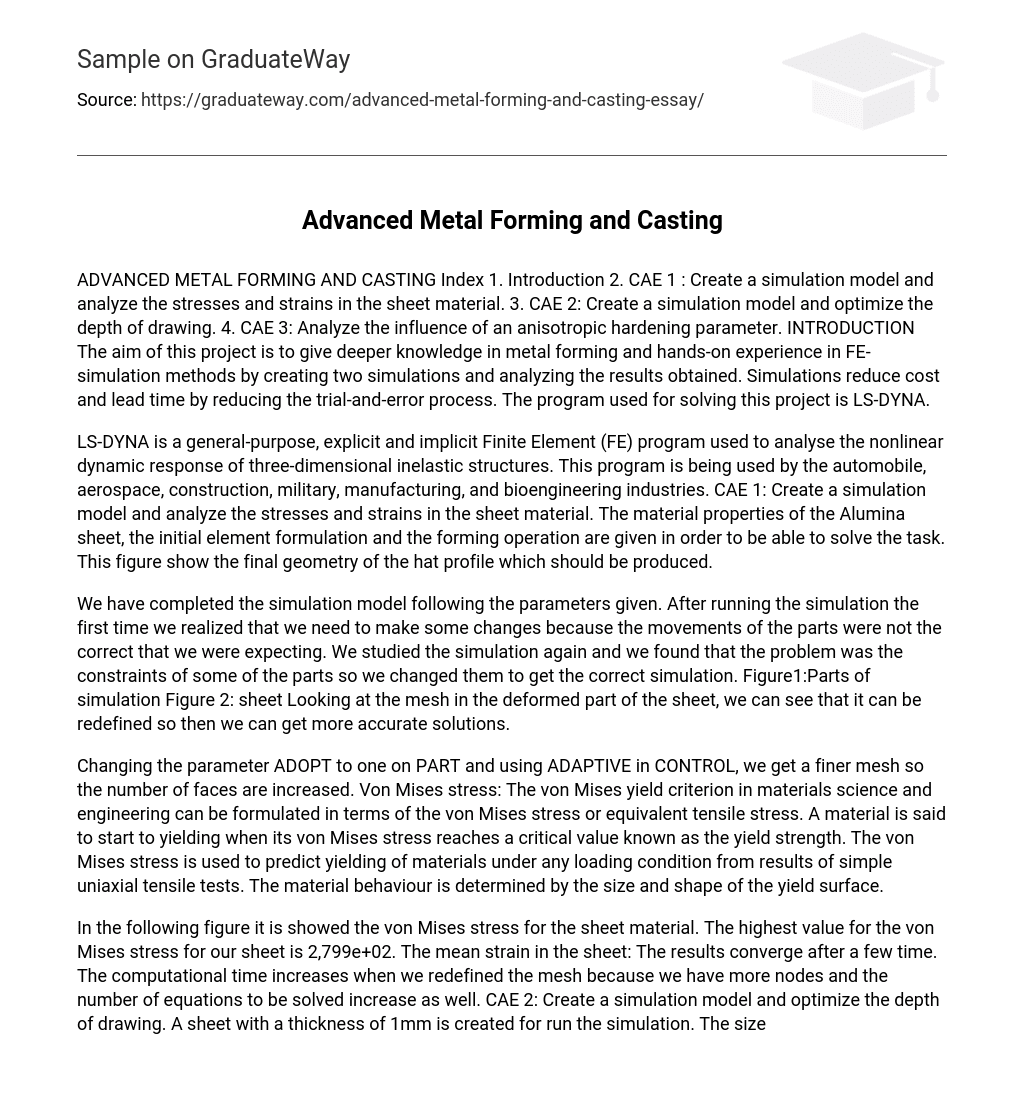ADVANCED METAL FORMING AND CASTING Index 1. Introduction 2. CAE 1 : Create a simulation model and analyze the stresses and strains in the sheet material. 3. CAE 2: Create a simulation model and optimize the depth of drawing. 4. CAE 3: Analyze the influence of an anisotropic hardening parameter. INTRODUCTION The aim of this project is to give deeper knowledge in metal forming and hands-on experience in FE-simulation methods by creating two simulations and analyzing the results obtained. Simulations reduce cost and lead time by reducing the trial-and-error process. The program used for solving this project is LS-DYNA.
LS-DYNA is a general-purpose, explicit and implicit Finite Element (FE) program used to analyse the nonlinear dynamic response of three-dimensional inelastic structures. This program is being used by the automobile, aerospace, construction, military, manufacturing, and bioengineering industries. CAE 1: Create a simulation model and analyze the stresses and strains in the sheet material. The material properties of the Alumina sheet, the initial element formulation and the forming operation are given in order to be able to solve the task. This figure show the final geometry of the hat profile which should be produced.
We have completed the simulation model following the parameters given. After running the simulation the first time we realized that we need to make some changes because the movements of the parts were not the correct that we were expecting. We studied the simulation again and we found that the problem was the constraints of some of the parts so we changed them to get the correct simulation. Figure1:Parts of simulation Figure 2: sheet Looking at the mesh in the deformed part of the sheet, we can see that it can be redefined so then we can get more accurate solutions.
Changing the parameter ADOPT to one on PART and using ADAPTIVE in CONTROL, we get a finer mesh so the number of faces are increased. Von Mises stress: The von Mises yield criterion in materials science and engineering can be formulated in terms of the von Mises stress or equivalent tensile stress. A material is said to start to yielding when its von Mises stress reaches a critical value known as the yield strength. The von Mises stress is used to predict yielding of materials under any loading condition from results of simple uniaxial tensile tests. The material behaviour is determined by the size and shape of the yield surface.
In the following figure it is showed the von Mises stress for the sheet material. The highest value for the von Mises stress for our sheet is 2,799e+02. The mean strain in the sheet: The results converge after a few time. The computational time increases when we redefined the mesh because we have more nodes and the number of equations to be solved increase as well. CAE 2: Create a simulation model and optimize the depth of drawing. A sheet with a thickness of 1mm is created for run the simulation. The size of the sheet is assumed to be the same as the blank holder, to make it easier.
The same procedure as in CAE1 is made for get a good simulation. After checking that the simulation is correct, running it and obtaining the good movements of all the parts, we start to analyze the results. This is our model simulation. We can optimize how deep the product can be drawn, looking at the plot of shear stress. We choose the appropriate depth by looking that no point of the sheet is over the shear limit. For a time of simulation of 0. 01864, which corresponds to 33. 5839 mm of deformation in the z direction, we obtain a good performance for our sheet material.
The velocity and pressure of the punch can modify the reaction of the sheet to the punch, so we have to take it into account when we model our simulation. For a higher pressure and velocity of the punch the limit can be overcome sooner. The dimensions of the sheet should also be taken into account to obtain a good behaviour of the mechanism. Previously we have supposed the same length as the blank holder because it could be easily defined. However, if we had less material, the resistance to the movement would be smaller. All these limits should be studied to achieve the better performance of the system.
CAE 3: Analyze the influence of an anisotropic hardening parameter. Using the simulation of CAE1 but changing the anisotropic parameter to R=1. 3 A material can have different yield stresses in different directions which result in anisotropic behaviour. Besides, the strains in the material could be anisotropic as well. The anisotropy in strain is usually defined by the Lankford parameters: Anisotropic behavior manifests itself in the case of a strain path change by different stress-strain responses depending on the type of the strain path change.
While many metals exhibit a drop of the yield stress after a load reversal, some metals show an increase of the yiled stress after an orthogonal strain path change ( cross hardening effect). This are the von Mises stress obtained for CAE1 with R=1. 3 The Von Misses Stress were recalculated for the new value of the anisotropic parameter. As it can be observed in the graphic, the new stresses are higher than before. The maximum stress for R=1. 3 is 3. 063e+02 while in the initial calculations (R=0. 81) was 2. 799e+02.





